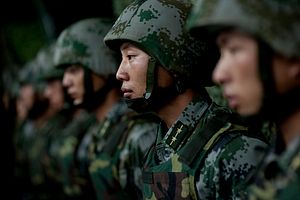On June 28, as the international community focused its attention on China’s imposition of a national security law on Hong Kong in recent days, Beijing announced its “decision to adjust the command mechanism of reserve forces,” expected to take effect from July 1. The reserve forces will be put under the centralized command of the Chinese Communist Party (CCP) and the party’s Central Military Commission (CMC), no longer under the dual command of military and local authorities.
Following the most recent round of military reform, China has reiterated the phrase “Military is military, police police, and civilians civilians.” Differentiated from the loosely structured militia, the reserve components of the Chinese military are mainly made up of ex-active service members, who form an order of battle in the same way as active services. According to geographical and administrative demarcation, there are provincial-level reserve divisions and local-level reserve brigades. There are also cross-region reserve divisions and cross-county regiments. As opposed to the militia, most of the reserve forces have the capability to operate heavy weapons and the experience of using them. Therefore, in accordance with the aforesaid guiding principle, the reserve components will surely be put under the unified command of the CMC. After all, the People’s Armed Police Force (PAP) has also been subjected to the command of the CMC. There is no reason why former service members who have just switched from active duty to reserve status should be under the dual command of military and local authorities.
In the wake of the military reform initiated in 2016, China has significantly revamped the structure and command mechanism of its military. It started with the re-organization of the CMC and the People’s Liberation Army (PLA), transformation of military regions into theater commands, and reform “from the neck down.” Reform continued with the subordination of the PAP, which was originally under the dual command of the CMC and the State Council but moved to the control of the CMC alone in 2018. Most recently, the China Coast Guard was placed under the command of the PAP. Now we have a newest case of the kind: The reserve forces, previously jointly commanded by military and local authorities, are now directly commanded by the CMC. From military restructuring, through the integration of rights protection agencies, to reform of the reserve forces mobilization system, we can see that the military reform is still ongoing and that despite the efforts over the past few years, the PLA cannot attend to all details in one single shot. The PLA still needs some time to test-run its new systems, which limits the possibility for it to launch a military campaign.
The reform of the reserve forces system this time is most likely motivated by a desire to improve China’s overall emergency response capabilities, whether in the context of the recent floods or to combat persistent threats from the COVID-19 pandemic. The PLA is most effective in handling disaster-related search and rescue missions, as reflected in the establishment of field hospitals, the transportation of supplies, command and control in disaster-affected areas, and preservation of social order. The PLA plays an important role in these matters. However, if first-line troops are mobilized to transport supplies or engage in other relevant tasks, the overall strength of the PLA might be affected as a result. In particular, under the impact of COVID-19 over the past few months, PLA troops in certain places may have to be quarantined for some time. This naturally results in a shortage of manpower. The militia is not comparable to first-line troops either in training intensity or in equipment operation. The reserve forces, meanwhile, used to be under the dual command of military and local authorities, and were likely not available for immediate deployment because of local interference. All these problems might have surfaced in recent post-disaster search and rescue missions, triggering the reform of the reserve forces system.
From now on, the reserve forces and provincial military districts will be commanded by the National Defense Mobilization Department of the CMC. President Xi Jinping now manages the military in a tighter way. Whether this is meant as a response to the increased interest in veterans affairs or veterans taking to the streets to claim their rights has yet to be found out.
Dr. Ying-Yu Lin is an adjunct assistant professor at the Institute of Strategic and International Affairs, located at National Chung Cheng University in Chiayi, Taiwan. He is also a research fellow with the Association of Strategic Foresight. Dr. Lin received his Ph.D. from the Graduate Institute of International Affairs and Strategic Studies, Tamkang University. His research interests include the development of PLA capabilities and cybersecurity issues.

































